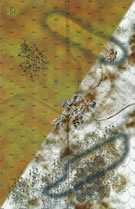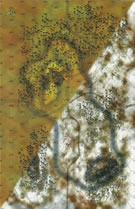|
Making Hay West Wall #8 |
||
|---|---|---|
| (Defender) Germany | vs | United States (Attacker) |
| Formations Involved | ||
|---|---|---|
| Germany |  |
301st Heavy Panzer Battalion |
| Germany |  |
3rd Panzergrenadier Division |
| United States |  |
104th "Timberwolf" Infantry Division |
| United States |  |
750th Tank Battalion |

|
| Overall Rating, 5 votes |
|---|
|
3.4
|
| Scenario Rank: 497 of 940 |
| Parent Game | West Wall |
|---|---|
| Historicity | Historical |
| Date | 1944-11-23 |
| Start Time | 09:30 |
| Turn Count | 18 |
| Visibility | Day |
| Counters | 90 |
| Net Morale | 0 |
| Net Initiative | 2 |
| Maps | 2: 24, 25 |
| Layout Dimensions | 56 x 43 cm 22 x 17 in |
| Play Bounty | 162 |
| AAR Bounty | 159 |
| Total Plays | 4 |
| Total AARs | 3 |
| Battle Types |
|---|
| Hill Control |
| Inflict Enemy Casualties |
| Rural Assault |
| Urban Assault |
| Conditions |
|---|
| Entrenchments |
| Off-board Artillery |
| Severe Weather |
| Scenario Requirements & Playability | |
|---|---|
| Cassino '44 | Counters |
| Elsenborn Ridge | Maps + Counters |
| West Wall | Base Game |
| Introduction |
|---|
|
Major General Terry de la Mesa Allen had always done things his own way, and to hell with the consequences. A personality conflict with his superiors had cost him command of the prestigious 1st Infantry Division earlier in the war, and he now commanded the newly-minted 104th Infantry Division. True to form, he had again alienated nearly all those around him with his bragging about how good his new division would be. |
| Conclusion |
|---|
|
The corps commander was ecstatic with the way the 104th Infantry was "making hay" and that Allen was making good on his boasts. Today Eschweiler was finally deemed secure, and the 414th Infantry Regiment advanced rapidly along the Indie River and reached Weisweiler. But the 413th Infantry Regiment ran into a juggernaut at Pultzjohn, with the 3rd Battalion being particularly hard hit and seven supporting Shermans lost. |
| AFV Rules Pertaining to this Scenario's Order of Battle |
|---|
|
| 4 Errata Items | |
|---|---|

|
The reduced direct fire value of the Heer HMG became 5-5 starting with Fall of France. (plloyd1010
on 2015 Jul 31)
|

|
The morale and combat modifiers of German Sergeant #1614 should be "0", not "8". (Shad
on 2010 Dec 15)
|

|
The SK 7/2 appearing in 1940: Fall of France is actually a SK 6/2, but misprinted by APL. Hence it should be unarmored in that game. The SK 7/2, which appears in other games is correctly printed with an armor of 0. (plloyd1010
on 2022 Apr 28)
|

|
Liberation 1944's Tiger movement and armor ratings are backwards. They should be Armor 7 and Movement 5. (petermc
on 2014 Feb 14)
|
| Down to the wire |
|---|
|
It came down to the wire. The US was making some good assaults and M4 flanking runs late in the game; the Germans were on the verge of losing when I repositioned the Tiger. After some complicated back and forth, which included some desperate US infantry assaults on the Tiger's town hex (give those guys a medal, they were all lost) to keep it from firing on the exposed M4s, the Tiger eventually got off some shots before the M4s could dash...it eliminated 3 steps (which translates to 6VPs) and that was enough to maintain the German draw and avoid a loss. The final VP tally was US 38 and Germany 34.5. Very close but a draw all the same. I really enjoyed this scenario. The early turns might feel a bit waste-ey, especially if the Germans play timidly early. It might be worth fighting forward though. |
| 0 Comments |
| Not As Much Blood Spilt As Expected | ||||||||||||||
|---|---|---|---|---|---|---|---|---|---|---|---|---|---|---|
This scenario was played over skype in two sessions against Alan Sawyer and represented my 10th and final visit to The Westwall scenario pack. German defences had to be centred on the town of Putzlohn and the high ground to the north and south of it. There was also an argument for defending the out-lying regions around the town as well, but this would stretch the rather thin coating of defenders to an overly diluted level. Therefore, one Hetzer pln and two grenadier plns were positioned on the northern high ground and its hamlet. A sole Tiger tank pln was dug-in on the southern hills. These would hopefully deter any enemy armoured advance toward Putzlohn. The rest of the defending forces were placed in Putzlohn itself. The plan for defence would be to hold all urban locations whilst slowly giving up the hill positions and extracting a heavy toll on the attackers at the same time. Simple in idea, worrying in prospect ! 0930 hours: The American 104th entered from the west in three main elements. One in the centre along the main road. This consisted generally of slow-moving MG’s and mortars, accompanied by some infantry and Sherman tanks. Flanking both sides of these troops were infantry blocks. In all, a regiment of infantry backed by plenty of OBA. The fly in the ointment though was the never-ending mud already experienced from Merzenhausen to Hucheln over the preceding week. (See scenarios 6,7,9 & 10 already AAR’d). This porridge like sludge would grind the infantry attack down in its advance and, without any forward defending Germans, mainly render American MG’s and mortar units worthless as they were so far away from the objective. For nearly 3 hours, the GI’s were left to struggle forward, virtually unmolested. Both sides jostled for better positions during the advance period and inflicted minimal losses on each other. One German mortar pln was lost in the bombardment of Putzlohn and a US engineer pln lost some men to accurate MG fire from the town when they become stuck in the mud about 600m away. By midday, the Tiger pln gave up its southern hill position to return to Putzlohn and the Hetzers to the north retired into the hamlet to beef up the grenadier platoon there. The American attackers had formed themselves into three distinct groups ahead of Putzlohn. Their experienced Lt.Col led from the centre and they were closing on the town under fire with the loss of 1 step of infantry. Another group veered south to try and stretch the defenders and the third group attempted to advance on the northern heights. Fortunately, for the Germans, American OBA, if not entirely ineffective seemed to prove always something their men could recover from. It did stir the German nest a little but failed to burst it open. 1230 hours (turn 13) seemed to turn the tide palpably towards the Germans. Although Americans had reached the edge of the town, many of them, rather than launch assaults, began to attempt to dig-in to firing positions close-by. Whilst doing this, German fire cut down a few of their number, causing some loss of cohesion. They were still without armour support as the M4’s dared not advance under the guns of nearby German tanks. In all, one platoon and half another were lost either to close in enemy fire or to the first assault that was finally launched. With the centre of the American line engaged so, the northern flank attempted to push ahead towards the hamlet. Here again, an advancing pln was ripped completely to shreds along with its Lieutenant as first the hetzer and grenadiers in the hamlet laced fire into them, followed up by enfilading fire from their flank facing Putzlohn. Furthermore, the small amount of German OBA had zeroed in on the clustered US MG teams that were struggling along the main road in the distance and had caused casualties amongst them. With casualties mounting, time running out and little prospect of advancing without taking yet more heavy fire, the Americans called off the attack. Not before they had a minor success in Putzlohn though. Their engineers assisted infantry in clearing one street of a whole enemy grenadier pln . But that was too little too late. Final losses, albeit, quite low for the battle, amounted to 3 German steps and 8 American steps. The Americans had taken about half of the high grounds and were contesting just 2 of the 8 or so urban hexes. This equated to a 33pts to 16.5pts advantage to the Germans. I really did not expect to win this one due to the scope of area requring defending coupled with the fact that the town of Putzlohn or Eschweiler (whichever one its meant to be) would not be enough points on its own. But once again the mud seemed to confound Alan's plans and hopefully so did some of my defence tactics ? I suspect Alan will be glad not to visit anywhere along the Siegfried line for a while yet ! Although not many casualties in this, I enjoyed the nip & tuck of the battle and ever changing positions of troops to try and retain advantages. A standard '3' rating for me this one and as always, will be keeping an eye out for future shared plays to see how others fare. |
||||||||||||||
| 0 Comments |
| Making Hay, not today. | ||||||||||||||
|---|---|---|---|---|---|---|---|---|---|---|---|---|---|---|
In an effort to get Vince Hughes his scenario ribbon we finished off the last West Wall scenario this past week. This one I thought might have potential for a US win but again it is a tough one with the Germans in a very strong position in the town. The Americans have a long slog through the mud once again to get to the town. This has two issues, one it burns turns and second most of the support weapons will not participate in the battle. This leaves the INF's to try to take the town. The Americans have good OBA so this support will be vital to the attack. For the Germans, they hold the town and will place all of there units in the town to hold it. Given the morale level of the Germans being equal to the US, it will be tough to dislodge them even with leaders and ENG's. Most of our game was spent with the Americans moving across the boards and the real fighting did not start until turns 10-11-12. German fire was on the mark and many US INF's were left on the advance to the town. The Americans did make it into two town hexes but could not get the Germans out. By turn 15 it was obvious the the Americans could not win. |
||||||||||||||
| 0 Comments |

 WeWa007
WeWa007 


























